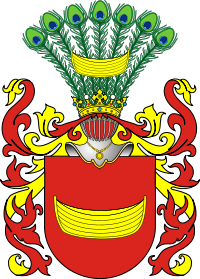|
Kurnatowski
The Kurnatowski family (Polish plural: Kurnatowscy) is a Polish aristocratic family. The family has been highly prominent for centuries, first in the Kingdom of Poland, later in the Polish–Lithuanian Commonwealth, and presently in the Republic of Poland. Since the 16th century, members of the Kurnatowski family have been active in politics, the arts, and military affairs. The family has maintained extensive wealth and land holdings, including palaces in Biezdrowo, Dusina, Gościeszyn, Kotowo, and Żołędowo. The family was first described in 1336 by Nicolaus Starogrodzki in Kreis Birnbaum. In 1902, a line was given the title of Count by edict of Pope Leo XIII. In 1916, another line received the title of Count from Tsar Nicholas II. HistoryThe Kurnatowski family was first described in 1336 by Nicolaus Starogrodzki in Międzychód. The name comes from the Kurnatowice, which was owned by the family since 1448. Originally the name was therefore Kurnatowski. During the 16th Century the family was consolidated under the name Kurnatowski. The family is part of the Łodzia clan and have been participants in politics, arts, and military endeavors. As magnates and members of the nobility, the Kurnatowski family has maintained extensive land holdings, including palaces in Biezdrowo, Dusina, Gościeszyn, Kotowo, and Żołędowo. The family's Golden Age was the 17th century, when its members accumulated much wealth and influence, held numerous important posts within the Polish–Lithuanian Commonwealth. The title of Count (Hrabia in Polish) was bestowed by Papal edict in 1902 to one of the branches of the family. Another line received the title of Count in 1916 from Tsar Nicholas II. Some members of the Kurnatowski family were ardent members of the Polish Reformed Church, or Calvinists, producing a number of clergymen, although the Duisina and other family lines have remained Roman Catholic since at least the 13th century. Coat of arms and mottoThe Kurnatowski family uses the Łodzia arms and the motto, My pływamy w krwi naszych wrogów ("We swim in the blood of our enemies"). Having first appeared in 1303, the arms are one of the oldest in Poland.[citation needed] Notable members
Bibliography
|
||||||||||||||||
